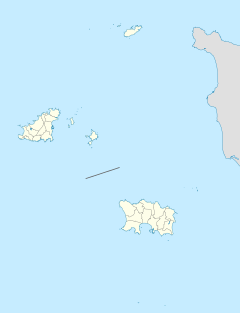Les Hanois Lighthouse

Les Hanois Lighthouse during a volcanic ash sunset (April 2010)
|
|
| Location | On Les Hanois, Guernsey |
|---|---|
| Coordinates | 49°26′06.2″N 2°42′08.4″W / 49.435056°N 2.702333°WCoordinates: 49°26′06.2″N 2°42′08.4″W / 49.435056°N 2.702333°W |
| Year first constructed | 1862 |
| Automated | 1996 |
| Construction | granite tower |
| Tower shape | tapered cylindrical tower with balcony, lantern, keeper's quarter and helipad above the lantern |
| Markings / pattern | white tower |
| Height | 36 m (118 ft) |
| Focal height | 33 m (108 ft) |
| Current lens | 4th order rotating optic |
| Light source | solar power |
| Intensity | 89,900 candela |
| Range | 20 nmi (37 km) |
| Characteristic | White group flashing twice, 3.2 seconds apart, every 13 seconds |
| Fog signal | Sounding twice every 60 seconds (range 2 nmi (3.7 km)) |
| Admiralty number | A1580 |
| NGA number | 8180 |
| ARLHS number | GUE-001 |
Les Hanois Lighthouse was constructed between 1860 and 1862 to a new design by James Douglass, and was first lit on 8 December 1862. It is sited on the rock known as Le Biseau, or Le Bisé, part of the reef Les Hanois one mile north west of Pleinmont where the Trinity House cottages were built. It was erected in response to an increasing number of shipwrecks on the treacherous rocks off the western coast of Guernsey.
Shipwrecks shortly before the construction included the wreck of HMS Boreas (![]() Royal Navy) in 1807 A further wreck in 1816 of the Marie Elizabeth, a merchant ship from Copenhagen, at Rocquaine triggered letters and discussions about undertaking a nobel project, Trinity House was contacted and in January 1817 about a possible lighthouse on the Pleinmont cliff top, they wrote back saying a lighthouse was not necessary as the lights on Les Casquets and at Portland were sufficient and a new lighthouse would be confusing and do more harm than good. The Trinity House Brethren appear to have misunderstood the request as these locations are 45km and 125km away and neither can be seen from south of Guernsey.
Royal Navy) in 1807 A further wreck in 1816 of the Marie Elizabeth, a merchant ship from Copenhagen, at Rocquaine triggered letters and discussions about undertaking a nobel project, Trinity House was contacted and in January 1817 about a possible lighthouse on the Pleinmont cliff top, they wrote back saying a lighthouse was not necessary as the lights on Les Casquets and at Portland were sufficient and a new lighthouse would be confusing and do more harm than good. The Trinity House Brethren appear to have misunderstood the request as these locations are 45km and 125km away and neither can be seen from south of Guernsey.
Additional ships were wrecked in 1820, 1834 and 1835, with pressure being exerted on Trinity House, who in 1847 reconsidered the proposal and sent a representative to visit the island. Local shipowners were against a tax to pay for a lighthouse as they knew of the dangers and did not need it. A further wreck in 1848 of the Emmanuel carrying timber from Canada to Hull had mistaken the Casquets light for the Portland light and erroneously sailed further south to disaster.
The Rector of Torteval proposed putting a light on the top of the 105m church steeple which was considered by Trinity House in 1849 as a possible cheap alternative, but after an inspection, the steeple was found to be unsuitable. Arguments for and against abounded, the Guernsey Chamber of Commerce were against, the Jersey Chamber was for, Trinity House was informed that they did not have jurisdiction to build a lighthouse in Guernsey and that Guernsey had no funds to pay for it. An article appeared in The Times on 15 July 1850 asking about the necessity of a Lighthouse at Pleinmont Point
...
Wikipedia

